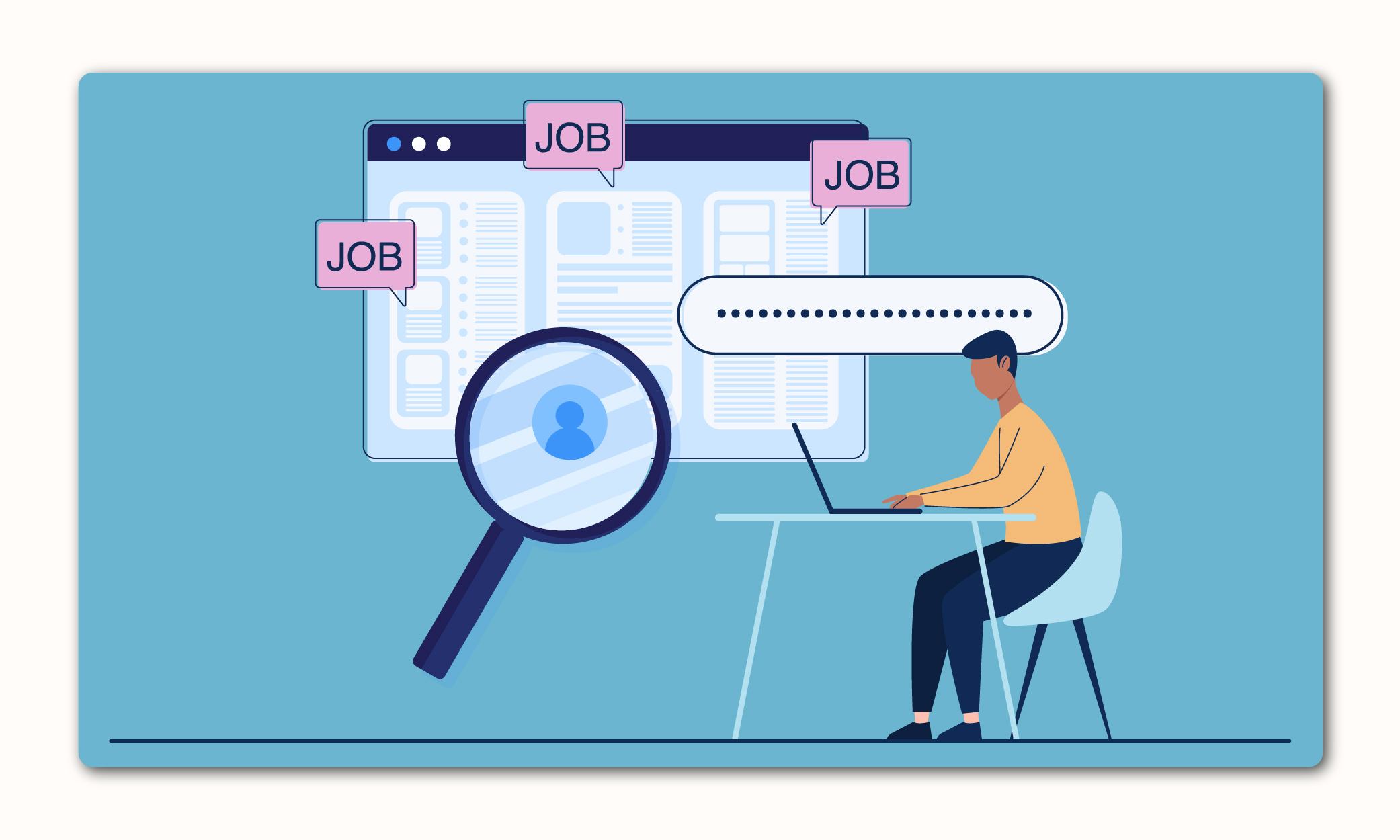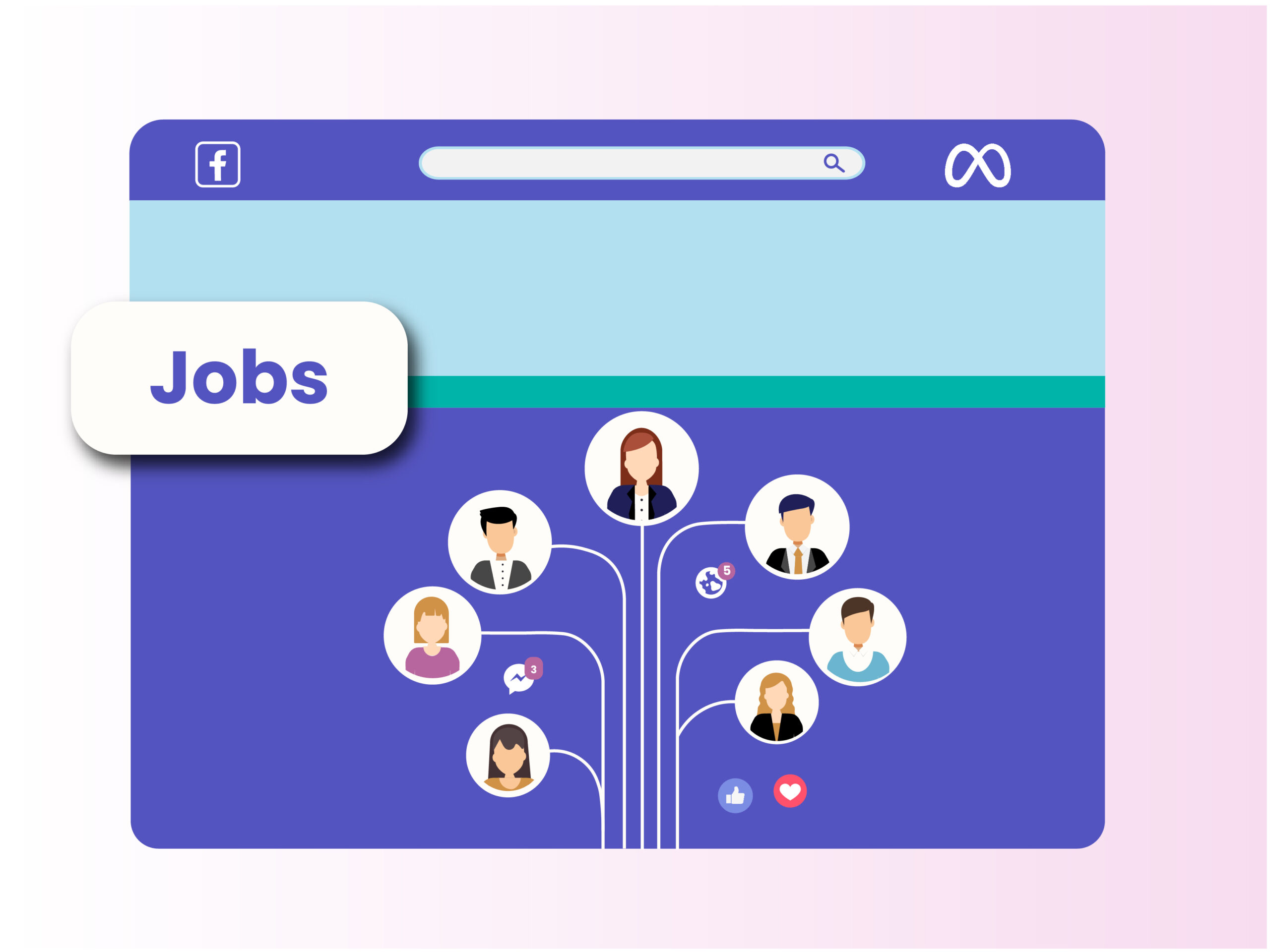What is Recruitment Marketing?
Recruitment marketing is changing the way companies find and recruit talent today. It is a strategic process that focuses on attracting, engaging, and nurturing talented individuals to fill job openings within an organization.
It’s a proactive approach, aiming to build relationships with potential candidates – sometimes long before a job opening is available. It involves using various marketing techniques, such as social media, content marketing, and employer branding, to showcase the organization’s culture, values, and opportunities. Recruitment marketing helps teams create a pipeline of qualified candidates, ensuring they have access to great-fit talent whenever needed.

How Is Recruitment Marketing Different From Recruiting?
Recruiting refers to the overall process of identifying, attracting, and hiring candidates to fill job positions within an organization. That includes activities such as posting job ads, reviewing resumes, conducting interviews, and making job offers.
Recruitment marketing, on the other hand, is a specific strategy used to attract and engage potential candidates to apply for a job. It involves using marketing techniques to promote the employer brand, attract top talent, and build relationships with potential candidates. This can include activities such as creating compelling job ads, leveraging social media to reach candidates, and showcasing company culture to attract talent.
Recruitment marketing is a subset of recruiting that specifically focuses on attracting and engaging candidates through targeted strategies and messaging.
Why Is Recruitment Marketing Important for Employers?
Today’s candidates are savvy consumers who research and evaluate employers thoroughly before applying. They read reviews, follow social media, and seek information about a company’s culture and values. This means employers need to actively manage their employer brand and reputation to attract top talent.
Recruitment marketing uses branding, messaging, and engagement strategies to attract candidates. By leveraging various channels and tools, such as social media, email, and analytics, employers can reach a wider audience and improve their recruitment outcomes. Recruitment marketers can see how well their strategies are working and make changes for the future.
Benefits of Recruitment Marketing for an Employer
- Wider talent pool: Recruitment marketing expands your reach beyond traditional methods, tapping into a larger pool of potential candidates. By being present on digital platforms and running targeted campaigns, you can attract diverse talent with the skills and experience your organization needs.
- More qualified candidates: Using targeted recruitment marketing, you can attract candidates who are not only interested in your company but also have the specific qualifications and skills required. This leads to a higher quality of applicants, making your hiring process more efficient.
- Improved candidate experience: With personalized communication and timely updates, you can build a positive relationship from the initial interaction to the final hiring decision. Providing a seamless experience without any hiccups not only attracts top talent but also fosters a lasting impression of your organization.
- A boost in candidate engagement: Recruitment marketing strategies, such as targeted content and interactive campaigns, help to keep candidates engaged throughout the hiring process. By offering valuable insights into your company culture, career opportunities, and application process, you can maintain their interest and encourage them to apply for open positions.
- Chance to improve the brand: With the shift in candidates’ priorities, showcasing your company’s values and culture has become critical. For example, by sharing employee testimonials or highlighting community involvement, you can create a compelling narrative that attracts candidates who align with your brand’s ethos. This, in turn, can motivate and engage employees!
- Cost-effective hiring: By targeting specific candidate segments and using digital channels, you can reduce dependence on expensive job boards and agencies. Plus, attracting candidates who are a better fit for your organization can lower turnover rates, further reducing hiring costs in the long run.
What Are the Components of Recruitment Marketing?
In recruitment marketing, a number of components work together to create a positive candidate experience, engage with potential applicants, and enhance the overall appeal of the employer brand.
- Candidate segmentation: Segmenting potential candidates based on the position offers many advantages. It helps you tailor advertising and content marketing strategies to specific applicant segments, ensuring the messaging resonates. A personalized approach increases the likelihood of attracting qualified candidates who are the right fit for your organization.
- Candidate experience and engagement: Engaging candidates and ensuring a positive experience are important pillars in recruitment marketing. This involves keeping qualified candidates interested and satisfied throughout their journey. Common strategies include email campaigns, newsletters highlighting career opportunities, regularly updated job openings, and providing timely and transparent feedback.
- Employer branding: This recruitment marketing component involves shaping and promoting the image of the company as an employer of choice. You can do this through various channels such as social media, career sites, and events. For example, showcasing employee success stories on social media.
- Social media reach: Being present on platforms like LinkedIn, Facebook, and X (formerly Twitter) to connect with potential candidates is a non-negotiable today. Companies can share job openings, employee testimonials, and content around company culture to engage with a wider audience. For instance, using hashtags and sharing visually appealing content can increase reach and engagement on social media.
- Job advertisements: Job ads are a cornerstone of recruitment marketing and serve as the primary means to attract potential candidates for open positions. They are posted on various platforms such as job boards, company websites, and social media channels. Crafting compelling job ads that clearly outline job responsibilities, qualifications, and company culture can significantly impact the quality and quantity of applicants.
- Employee referrals: Leveraging your employee network to attract top talent is a powerful move. Companies often incentivize employees to refer candidates, offering rewards for successful hires. This approach not only brings in candidates who are likely a good cultural fit, but also helps in creating a positive employer brand.
- Recruitment marketing analytics: Data, data, data! By tracking metrics like candidate sources, application rates, and cost per hire, you can assess the performance of your efforts. For example, analyzing which channel brings in the most qualified candidates can help in optimizing recruitment budgets and strategies.
Let’s dive into the numbers, with the latest talent sourcing and recruitment advertising benchmarks!
Ready to Let the Data Do the Talking?
What Is a Recruitment Marketing Funnel?
The recruitment marketing funnel is a visual representation of the candidate journey, from initial awareness to application to hiring. It helps recruiters understand the stages candidates go through and tailor their strategies accordingly.
The recruitment marketing funnel is important because it allows recruitment teams to track and optimize their efforts for the best ROI. By understanding where candidates are in the funnel, recruiters can create targeted campaigns and content that appeals to them. It also helps in measuring the success of recruitment efforts and improving the overall candidate experience.
The funnel consists of several stages, starting with creating awareness about job opportunities and the company. This is followed by the consideration stage, where candidates evaluate their options and decide to apply. Finally, there’s the decision stage, where all the post-apply stages like shortlisting, interviews, and offers come into play. Each stage requires different strategies and tactics to move candidates down the funnel.
Stages of a Recruitment Marketing Funnel
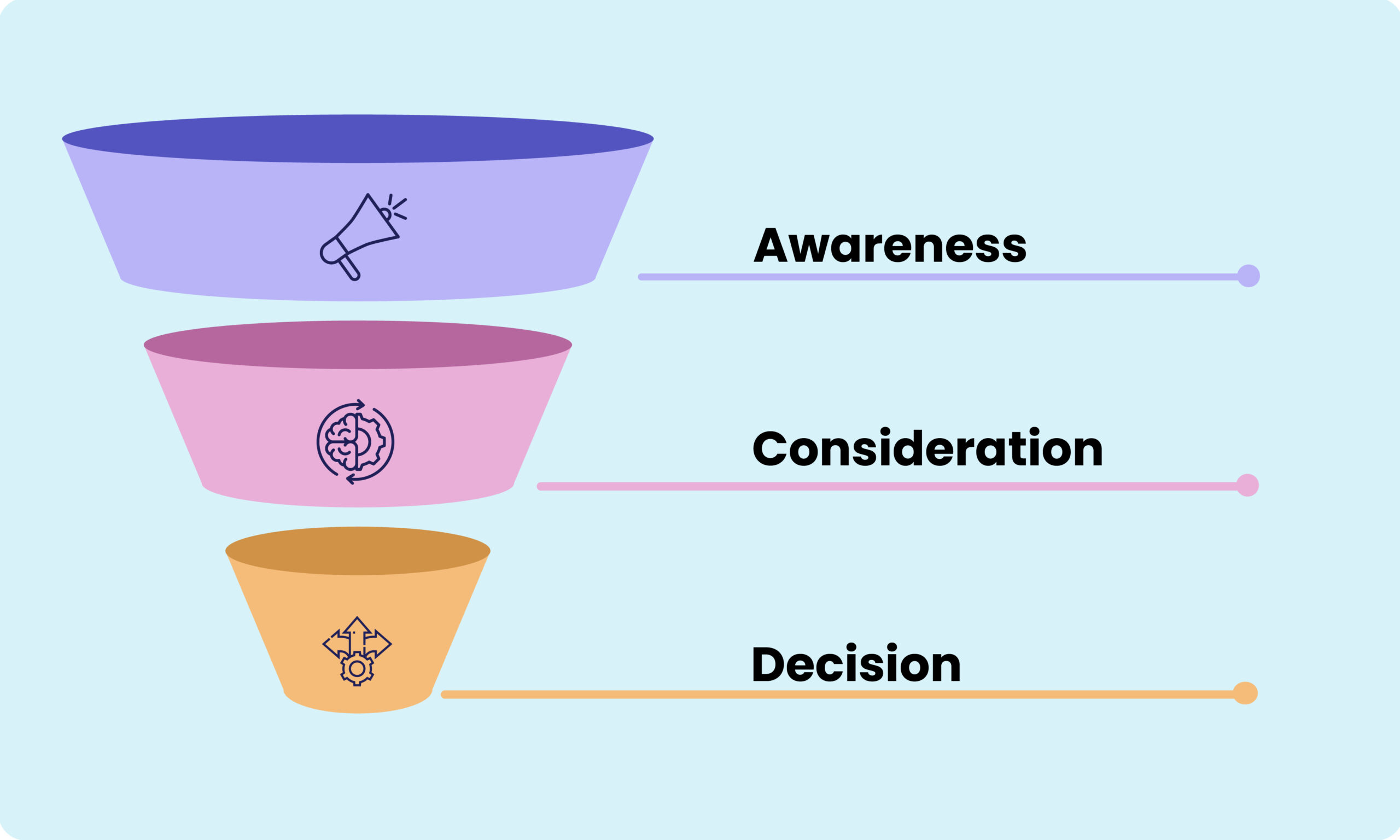
Awareness
This is where the recruitment marketing journey begins. Candidates start to notice your company and its job openings, and you want to create a positive impact. This can happen through job postings on websites, social media posts and ads, or word of mouth. The goal is to make your company and job opportunities stand out from the competition and entice potential candidates to learn and explore more.
Consideration
In this stage, candidates are intrigued and want to learn more about your company and the roles you offer. They might click on your job postings to read more details. Candidates are exploring your company culture, benefits, and growth opportunities to see if they align with their career goals. This is the stage where you want to showcase why your company is a great place to work.
Once the candidate feels comfortable with all the info they’ve gathered about your company, they decide to take the plunge. Post application, they seek deeper insights into your company’s values and work environment, often researching employee reviews and company news to feel confident about their application.
Decision
After applying, candidates enter the post-apply stages: shortlisting for interviews, rounds of interviews, receiving a job offer, and finally, getting hired. This stage is about sealing the deal and convincing candidates that your company is the best choice for their career.
Understanding these stages is crucial for putting together strategies to attract and engage candidates at each step of the funnel, ultimately leading to successful hires.
How to Develop a Recruitment Marketing Plan
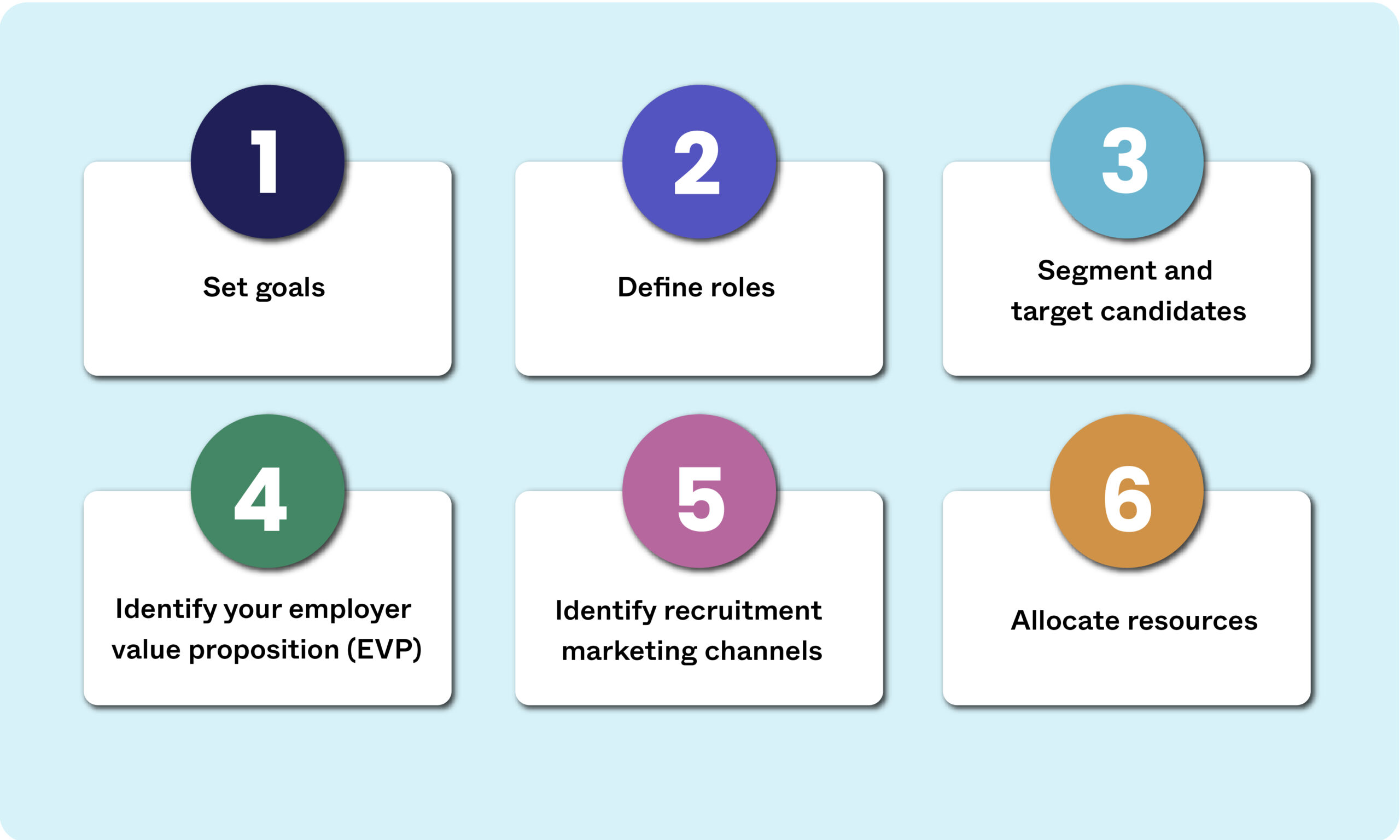
- Set goals: Consider what you want to achieve, such as increasing the number of qualified applicants or improving your employer brand awareness. Setting goals helps you stay focused and measure the success of your recruitment marketing efforts later.
- Define roles: Identify the specific job roles for which you want to implement recruitment marketing efforts. Determine the key skills, qualifications, and characteristics of the ideal candidates for these roles. This helps you tailor your recruitment marketing strategies to attract the right candidates for each position.
- Segment and target candidates: Divide your target audience into segments based on factors such as skills, experience, and interests. This allows you to create targeted messaging and content that resonates with each segment. For example, you might create different campaigns for recent grads and experienced professionals to appeal to their specific needs and preferences.
- Identify your employer value proposition (EVP): Your EVP is what sets you apart as an employer and why top talent should choose to work for your organization – not the other folks. Identify the unique benefits and opportunities you offer, such as career development programs, a positive work culture, or competitive salaries. Highlighting your EVP in your recruitment marketing efforts helps attract candidates who align with your values and goals.
- Identify recruitment marketing channels: No more guessing. Identify the best channels to reach your target candidates, such as social media, job boards, career fairs, and your company website. Create a calendar to plan your content creation and distribution schedule for each channel. This helps you stay organized and ensures that you are consistently sharing great content with your target candidates.
- Allocate resources: You need resources to execute your recruitment marketing plan effectively. This includes budget, manpower, and tools or technologies. Allocate resources based on your specific goals and the importance of each recruitment channel as per your plan. This ensures that you have the necessary support to make your plan a success.
Best Practices for Recruitment Marketing
- Invest in a multi-channel approach: To reach a diverse pool of candidates, use multiple channels such as social media, job boards, candidate relationship management (CRM) tools, and employee referrals. This approach ensures your message reaches a wider audience, increasing the chances of attracting qualified candidates. Diversifying your channels also helps you adapt to changing trends and reach candidates where they live.
- Use both organic and paid advertising: Employ a combination of organic and paid advertising strategies to make the most of your recruitment efforts. Organic methods, such as posting job openings on your company’s social media pages and website, can help attract candidates who are already interested in your brand. Meanwhile, paid advertising, such as targeted ads on social media platforms or job boards, can help reach a wider audience and attract passive candidates. By using both approaches, you can increase your chances of finding qualified candidates and filling your open positions faster.
- Optimize your application process: Make sure your application process is user-friendly and efficient. Ask for essential information and avoid lengthy questionnaires. Test the application process yourself to identify any potential issues or bottlenecks. A streamlined application process can improve the candidate experience and increase the likelihood of qualified candidates completing their application.
- Repurpose content: Repurposing content involves using existing content in different formats or across various platforms. This practice not only saves time but also ensures consistent messaging across all channels. For example, you can turn a blog post into a series of social media posts, a video, or an infographic. Consistent messaging helps reinforce your employer brand and keeps your audience engaged across different platforms.
- Don’t leave data behind: Track metrics such as application rates, source of hires, and cost per hire to understand what’s working and what’s not. This data-driven approach allows you to make informed decisions and optimize your recruitment efforts for better results.
- Use AI: The world is changing, and quite rapidly with the wide adoption of AI. Make sure you do your research and identify places to use AI to streamline your recruitment process. It can help automate repetitive tasks, create content, analyze data to predict candidate behavior, and improve the overall efficiency of your recruitment efforts.
From features and benefits, to insights about the future of AI in the world of recruitment, we’ve got it all.
Wondering How AI Can Help You Rock Your Talent Acquisition Goals?
Recruitment Marketing Examples to Learn From
1. Google’s clever recruitment billboard
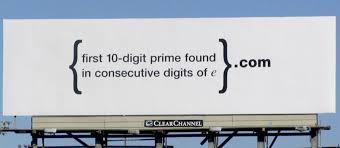
Google’s 2004 billboard puzzle was a recruitment marketing hit. The billboard featured a complex math problem, challenging viewers to solve it. The solution led to a website with another puzzle. Successful solvers were directed to Google Labs, where they were welcomed as top engineer candidates. This clever campaign showcased Google’s innovative culture and attracted top talent.
2. IKEA’s creative hiring strategy: Assemble your future
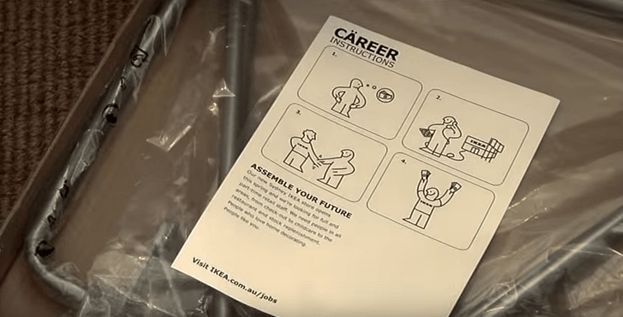
IKEA’s “Assemble Your Future” campaign placed job instructions inside product boxes, inviting customers to apply. This creative approach not only filled 280 positions but also engaged brand-loyal customers. The reason behind this campaign’s success was its personalized and innovative connection with candidates that stood out in a crowded market.
3. McKinsey & Company: The eraser pencil campaign

McKinsey & Company’s campus recruitment used unique pencils with long erasers to attract ambitious students. The message on the pencils was “We’re looking for students who aren’t satisfied with just any solution.” The message encouraged students to visit McKinsey’s website. This creative approach aimed to attract curious innovators and resulted in high-quality graduate hires. This approach proved that effective recruitment doesn’t have to be costly or complex.
4. Inside Marriott: How their careers page sets the standard
Marriott excels in recruitment marketing with its highly engaging and personalized careers page with 1.2 million likes and daily updates. The career page showcases individual employee achievements, offers insights into a day in the life at Marriott, and shares regular updates (twice a day) from across their existing network. This personalized approach allows potential candidates to connect with the brand on a deeper level.
5. Personal touch with custom iPods

To compete with huge software companies for talent, Red 5 Studios sent personalized iPods to 100 ‘dream’ candidates. Each iPod featured a recorded message from CEO Mark Kern discussing the candidate’s work and inviting them to apply. This creative approach resulted in a 90% response rate and 3 successful hires.
6. Ogilvy: The world’s greatest salesperson

In order to find ‘The World’s Greatest Salesperson,’ Ogilvy, a top advertising agency, launched a unique recruitment campaign. Using targeted social media ads and their YouTube channel, they challenged candidates to sell a brick in a video. The prize? A three-month paid internship at Ogilvy and the opportunity to pitch at the Cannes Lions International Advertising Festival.
7. How LEGO found Its master model builder
For the unique role of a professional LEGO builder, LEGO organized a competition. Contestants were given theme-based challenges to build the best LEGO model within a time limit. The competition was organized in front of a live audience and it featured a three-round knockout format. The winner of the final round, known as a ‘night build,’ was immediately hired in front of the live audience.
8. Atlassian’s creative bus recruiting
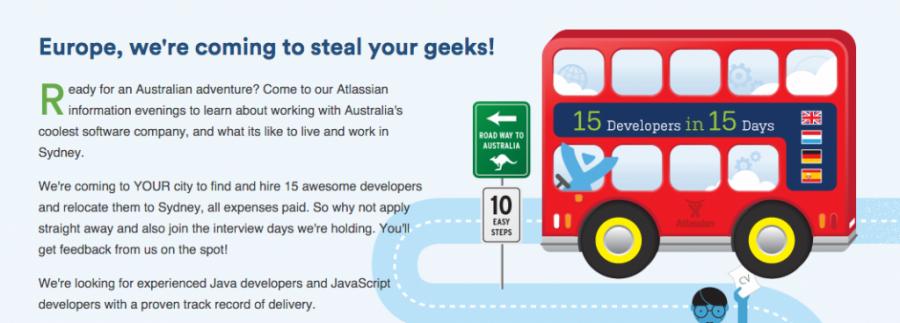
Atlassian, an Australian software company, faced a shortage of engineers. Their solution? They transformed a bus into a mobile recruitment hub, traveling across Europe to meet and interview potential hires. Candidates could follow the bus’s journey online and apply for a chance to join the tech scene in Sydney.
9. Turning stereotypes into strengths: The UK Army’s millennial campaign

With recruitment marketing, creativity and audience understanding are key. The UK Army’s 2019 campaign brilliantly targeted millennials, turning perceived negatives like “selfie-addicts” and “binge-gamers” into positives by reframing them as confidence and drive, respectively. Despite criticism, the campaign boosted applications by over 4,000 in a month, with 2,700 in just five days.
10. Cisco: Be you, with us
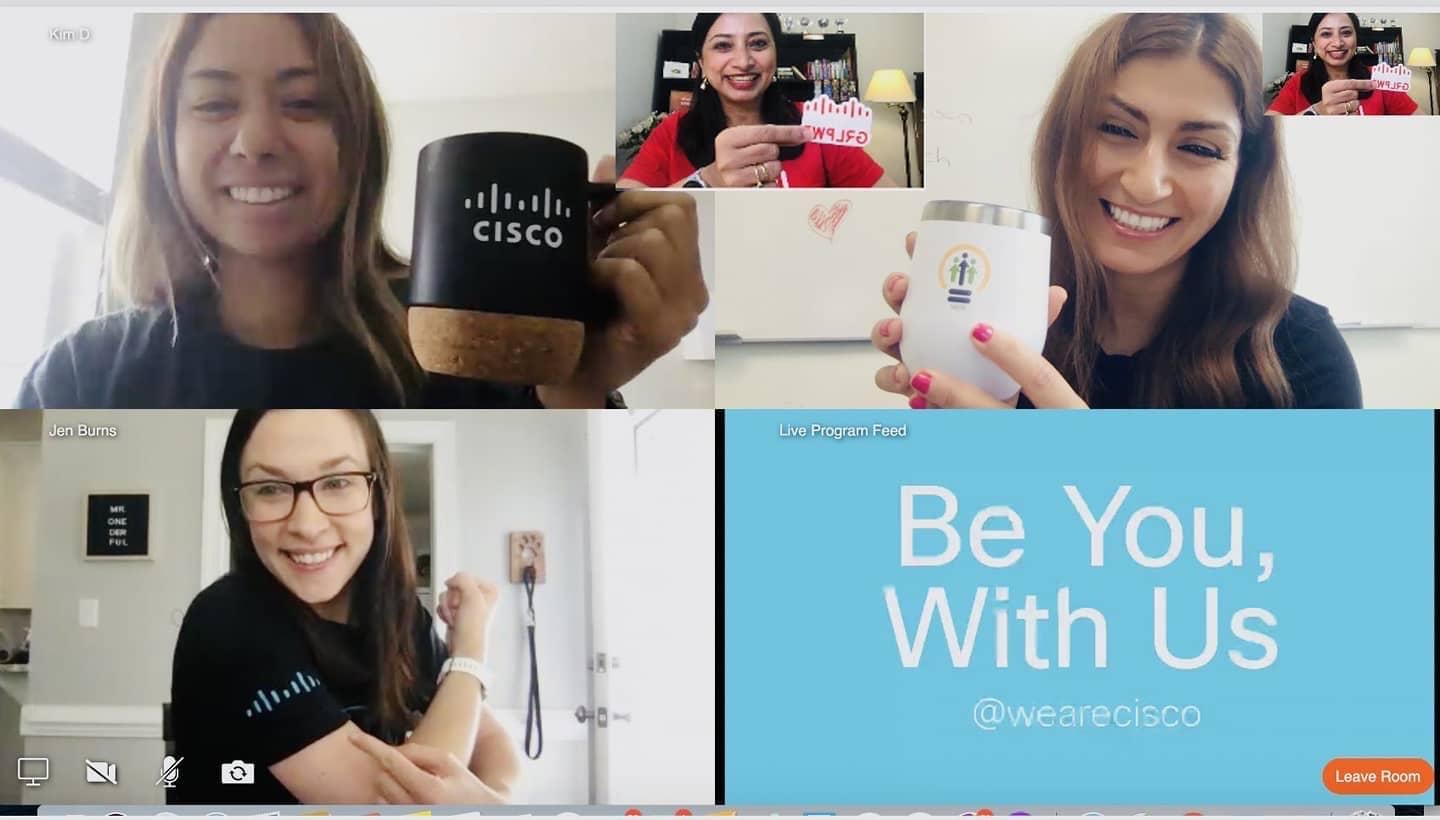
Involving your current employees in your recruitment marketing efforts, as Cisco did, can be incredibly effective. Cisco’s “Be you, with us” campaign featured employees showcasing the company’s culture and values. This approach highlighted the unique perspectives within the company and attracted like-minded applicants who valued individuality and inclusivity. With this campaign, Cisco not only attracted great candidates but also created a unique brand identity across their social media channels.
11. Focus on the UX like Eurowings Airlines
A positive user experience (UX) can significantly impact candidate engagement and application rates in recruitment marketing campaigns. In 2018, Eurowings turned job postings into Tinder profiles, allowing job seekers to swipe left or right. This interactive approach, inspired by the popular dating app, resulted in a fun and effective recruitment strategy.
12. 60 second challenge by Quixey
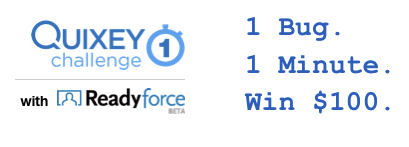
Silicon Valley startup Quixey, competing with big companies like Facebook and Google for the best employees, came up with an interesting challenge. They asked engineers to solve a quick programming puzzle in 60 seconds and offered a $100 reward daily for a month. This move not only gave the winners cash but also gave Quixey exclusive access to talented candidates. Many of these candidates have since joined Quixey’s team, making it a win-win situation.
13. MGM Grand’s cooking competition
MGM Grand wanted a new head chef for one of its restaurants, so they organized their own cooking competition, inspired by the TV show ‘Iron Chef’. Teams from all 16 eateries in the casino, including chefs and cooks from different restaurants, were given a surprise ingredient. They had to create a four-course meal in less than an hour. The winner was a 23-year-old sous chef from a 24-hour coffee shop. Since the chef’s joining, the Japanese restaurant’s sales have increased by 400%!
14. Mastercard Canada: Social media challenge
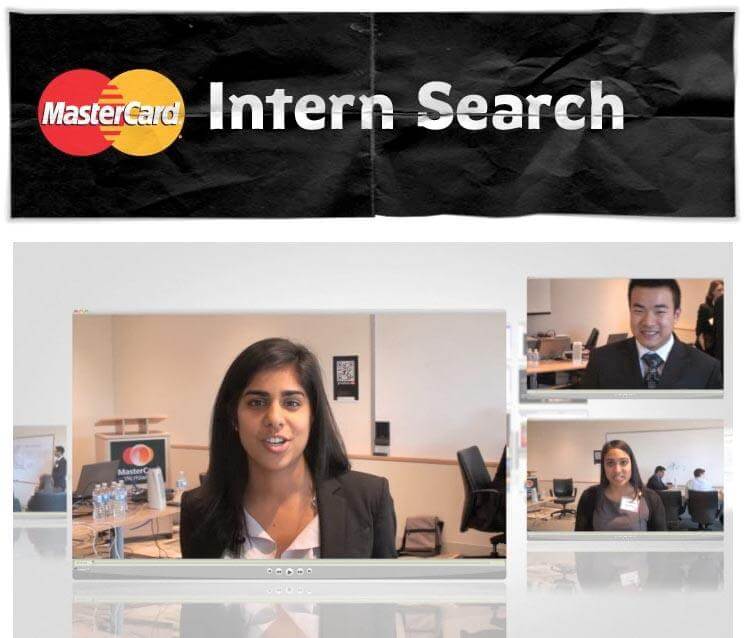
With college students eagerly searching for internships, Mastercard Canada came up with a brilliant idea to target them. They launched a social media competition, using the hashtag #internswanted, where students could compete for an internship. To enter, students had to pitch an idea for a product, app, or method to advance the company’s move towards a cashless future. The number of ‘likes’ and ‘retweets’ each idea received determined the winners. The contest attracted 532 qualified candidates, prompting Mastercard Canada to hire an extra intern to accommodate the high caliber of talent.
15. Jung V Matt: Lorem ipsum job description
Imagine you’re a designer using the ‘Lorem Ipsum’ generator, just minding your own business. Suddenly, you stumble upon a job description in the Lorem Ipsum text. It’s actually a clever recruitment tactic by the German advertising agency Jung von Matt! They embedded job offers in the Lorem Ipsum text, reaching 200,000 designers. This creative campaign led to 14,000 visits to their careers website and sparked a lot of buzz on social media.
16. Royal Marine Commando: The bold campaign
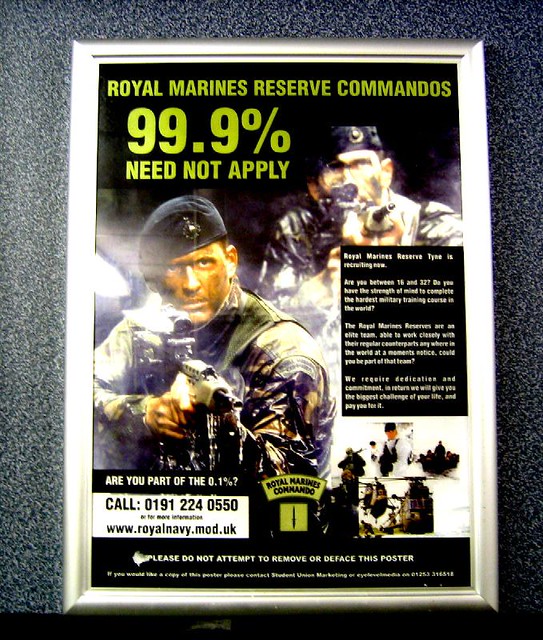
The Marines launched a bold campaign called “99% need not apply.” This campaign highlighted the intense determination, athleticism, and focus needed to become a Royal Marine. Completing the commando training is no easy feat, and only a small number of recruits make it through. The campaign was a direct challenge to potential applicants, daring them to prove they had what it takes to succeed. This provocative approach not only won awards but also helped the Marines attract the right kind of candidates.
17. How Uncle Grey used gaming for talent discovery
Danish agency Uncle Grey faced challenges in hiring front-end developers through traditional methods. To reach their target market, they partnered with top players in the popular online game ‘Fortress 2’. These players acted as company ambassadors, distributing posters and promoting the recruitment page URL within the game. This unique approach led to over 50 applications and helped Uncle Grey find their ideal candidate in just one week.
Conclusion
Recruitment marketing is all about creating meaningful connections with candidates, showcasing your company’s culture, and standing out in a competitive market. By implementing the strategies and best practices outlined in this guide, you can attract top talent, enhance your employer brand, and build a strong foundation for future recruitment success.
Recruitment marketing is an ongoing process that requires constant evaluation and adaptation to meet the ever-changing needs of your target audience. With proper planning and creativity, you can create a recruitment marketing strategy that sets your company apart and attracts great-fit candidates for your team!
FAQs
How does recruitment marketing differ from traditional recruiting methods?
Recruitment marketing focuses on attracting talent to the company as a whole, not just filling specific job openings. It uses marketing strategies to build relationships and create positive candidate experiences, treating candidates more like consumers.
What is a recruitment marketing plan?
A recruitment marketing plan is a strategic roadmap that outlines how an organization will attract, engage, and hire top talent. It aligns recruitment efforts with overall business objectives, defining goals, target candidates, marketing channels, content creation, and measurement strategies.
What are the key components of an effective recruitment marketing strategy?
The key components of an effective recruitment marketing strategy include employer branding, candidate segmentation, a multi-channel approach, engaging content, a positive candidate experience, and measurement and analytics to track performance and make improvements.
How can companies measure the success of their recruitment marketing efforts?
Companies can measure the success of their recruitment marketing efforts through metrics like application rate, source of hires, cost per hire, time to fill, and quality of hire. Data and analytics help track performance and effectiveness, allowing companies to optimize their strategies for better results.
Looking to streamline your recruitment efforts?
- Try our Job Description Optimizer for quick, effective job descriptions.
- Forecast your ad spend with the CPA Calculator.
- Need help choosing vendors? Explore our RFP Templates for expert guidance.
Also read:
